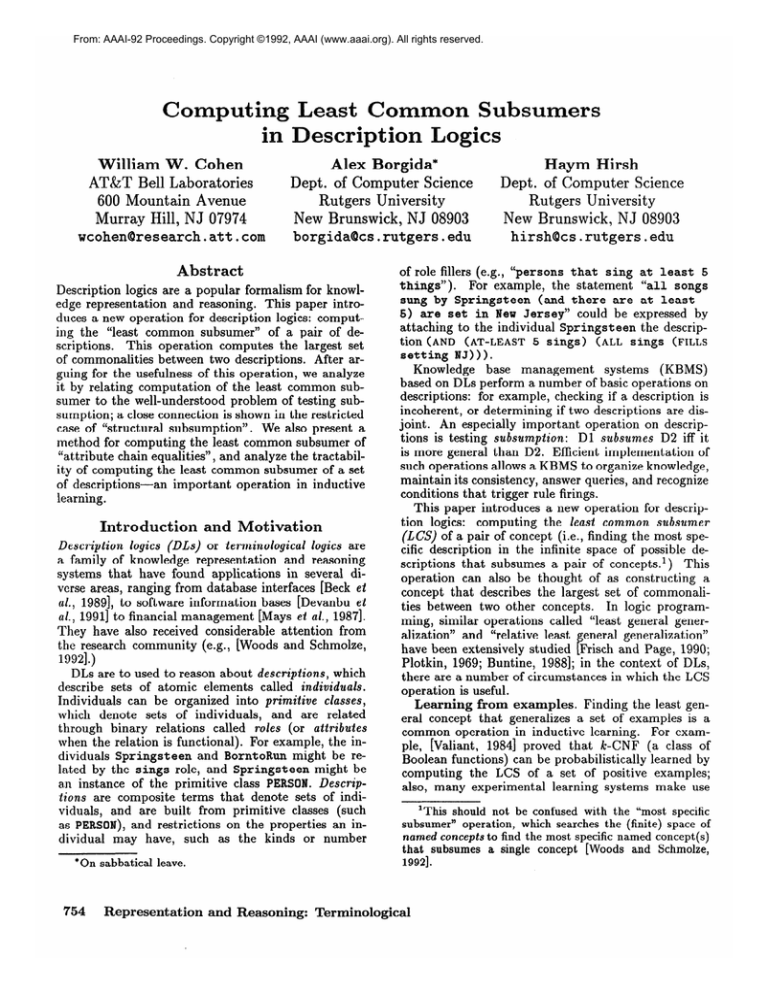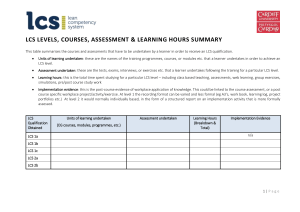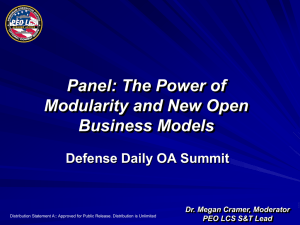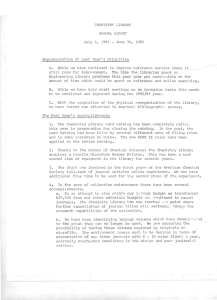
From: AAAI-92 Proceedings. Copyright ©1992, AAAI (www.aaai.org). All rights reserved.
Computing
Least Common Subsumers
in Description Logics
William W. Cohen
AT&T Bell Laboratories
600 Mountain Avenue
Murray Hill, NJ 07974
wcohen@research.att.com
Alex Borgida*
Dept. of Computer Science
Rutgers University
New Brunswick, NJ 08903
borgida@cs.rutgers.edu
Abstract
Description logics are a popular formalism for knowledge representation and reasoning. This paper introduces a new operation for description logics: computing the “least common subsumer” of a pair of descriptions.
This operation computes the largest set
of commonalities between two descriptions. After arguing for the usefulness of this operation, we analyze
it by relating computation of the least common subsumer to the well-understood problem of testing subsumption; a close connection is shown in the restricted
case of “structural subsumption”.
We also present a
method for computing the least common subsumer of
“attribute chain equalities”, and analyze the tractability of computing the least common subsumer of a set
of descriptions -an
important operation in inductive
learning.
Introduction and Motivation
Description
logics (DLs) or terminological
logics are
a family of knowledge representation and reasoning
systems that have found applications in several diverse areas, ranging from database interfaces [Beck et
al., 19891, to software information bases [Devanbu et
al., 19911 to financial management [Mays et al., 19871.
They have also received considerable attention from
the research community (e.g., [Woods and Schmolze,
1.9921.)
DLs are to used to reason about descriptions, which
describe sets of atomic elements called individuals.
Individuals can be organized into primitive classes,
which denote sets of individuals, and are related
through binary relations called roles (or attributes
when the relation is functional). For example, the individuals Springsteen
and BorntoRun might be related by the sings role, and Springsteen
might be
an instance of the primitive class PERSON. Descriptions are composite terms that denote sets of individuals, and are built from primitive classes (such
a.s PERSON), and restrictions on the properties an individual may have, such as the kinds or number
*On sabbatical leave.
754
Representat ion and Reasoning:
Haym Hirsh
Dept. of Computer Science
Rutgers University
New Brunswick, NJ 08903
hirshQcs.rutgers.edu
of role fillers (e.g., “persons that sing at least
5
things”).
For example, the statement “all songs
sung by Springsteen
(and there
are at least
6) are set in New Jersey”
could be expressed by
attaching to the individual Springsteen
the description (AND (AT-LEAST 5 sings)
(ALL sings (FILLS
setting
NJ))).
Knowledge base management
systems
(KBMS)
based on DLs perform a number of basic operations on
descriptions: for example, checking if a description is
incoherent, or determining if two descriptions are disjoint. An especially important operation on descripDI subsumes D2 iff it
tions is testing subsumption:
is more general than D2. Efficient implementation of
such operations allows a KBMS to organize knowledge,
maintain its consistency, answer queries, and recognize
conditions that trigger rule firings.
This paper introduces a new operation for description logics: computing the least common subsumer
(LCS) of a pair of concept (i.e., finding the most specific description in the infinite space of possible descriptions that subsumes a pair of concepts.‘)
This
operation can also be thought of as constructing a
concept that describes the largest set of commonalities between two other concepts.
In logic programming, similar operations called “least general generalization” and “relative least eneral generalization”
have been extensively studied i!Frisch and Page, 1990;
Plotkin, 1969; Buntine, 19SS]; in the context of DLs,
there are a number of circumstances in which the LCS
operation is useful.
Learning from examples. Finding the least general concept that generalizes a set of examples is a
common operation in inductive learning. For example, [Valiant, 19841 proved that L-CNF (a class of
Boolean functions) can be probabilistically learned by
computing the LCS of a set of positive examples;
also, many experimental learning systems make use
‘This should not be confused with the “most specific
subsume?’ operation, which searches the (finite) space of
raarraedconcepts to find the most specific named concept(s)
that subsumes a single concept [Woods and Schmolze,
19921.
Terminological
of LCS-like operations [Flann and Dietterich, 1989;
Hirsh, 19921. A companion paper explores the learnability of DLs via LCS operations [Cohen and Hirsh,
19921; DLs are useful for inductive learning because
they are more expressive than propositional logic, but
still (in some cases) tractably learnable.
Knowledge-base
“vivification” (e.g.
[Borgida
and Etherington, 1989; Levesque, 19861). Reasoning
with a knowledge base that contains disjunctive facts
is often intractable.
Vivification is a way of logically
weakening a knowledge base to avoid disjunction: for
example, rather than encoding in the knowledge base
the fact that PIANIST( Jill)
V ORGANIST( Jill),
one
might elect to encode some conjunctive approximation
to this disjunction, such as KEYBOARD-PLAYER( Jill).
In DLs that reason tractably with non-disjunctive descriptions, replacing a disjunction D1 V . . . V D, with
, Dn is a vivification operation, as it
theLCSofDl,...
leads to an approximation that can be reasoned with
effectively.
Other reasoning tasks. Frish and Page [19901 argue that certain types of abduction and analogy can
also be performed using LCS operations. Also, many
specific applications of LCS operations have been described. For example, Schewe [1989] proposes an approach to the important problem of developing of variants of existing software using the Meson DL; a key
notion in his approach is the use of the LCS of pairs
of descriptions, denoting the desired and existing portions of code respectively.
In the remainder of this paper, we first precisely define the LCS of two descriptions.
We then develop
an understanding of the LCS operation by analyzing the relation of LCS to the well-studied and wellunderstood problem of subsumption. A close connect’ion is shown for the special case of “structural subsumption”: for example, given a recursive structural
subsumption algorithm and definitions of LCS for the
base cases one can mechanically construct a recursive
LCS algorithm. Finally, we analyze the complexity of
computing the LCS of attribute chain equalities, an
important construct for DLs that normally requires a
non-structural subsumption algorithm.
Our results are not specific to any particular DL;
however, we will present our examples in a specific DL,
namely CLASSIC [Borgida et al., 19891, the syntax of
which is summarized in an appendix.
The lcs
Operator
Let ,$ be a description logic and let q
be its subsumption relationship-i.e.,
if description Dl subsumes D2
then we will write D2==.+Dl. By definition, must
be a partial order on (denotations of) descriptions. It
is possible that Dl=+D2
and D2eDl
without Dl
and D2 being syntactically identical; in this case, we
will say that Dl and D2 are semantically equivalent,
and write DlzD2.
C E L is a least common subsumer
@C’S) of Dl and D2 iff a) C subsumes both Dl and
D2, and b) no other common subsumer of Dl and D2
is strictly subsumed by C.
Notice that in general, a least common subsumer
may not exist, or there may be many semantically different least common subsumers. We define the Zcs operator to return a set containing exactly one representative of the equivalence class (under G-) of every least
common subsumer of Dl and D2. More precisely:
nition 1 If Dl and 02 are concepts in a descriplanguage f, then lcs(Dl,DZ)
is a set of concepts
{Cl,. . . , ci, . . .} such that a) each Ci is a least common subsumer of Dl and 02, b) for every C that is a
least common subsumer of Dl and 02, there is some
Ci in lcs(Dl,DZ)
such that Ci z C, and c) for i # j,
Ci $ Cj.
However, all extant DLs provide some description
constructor (usually called AND) which builds a description whose denotation is the intersection of the
denotation of its arguments. If such a constructor exists, then it can be shown that if any least common
subsumer exists, it is unique up to equivalence under
3. We have the following proposition.
roposition 1 For any DL with the description intersection
constructor
(AND), if lcs(Dl,DZ)
is not
empty, then it is a singleton set.
(Proof by contradiction:
if two incomparable LCS
exist, their intersection is a more specific common subsumer, which could not be equivalent to them.) In
the remainder of the paper, we will consider only DLs
equipped with a constructor AND.
elating ICS and Subsumption
The choice of constructors available for building descriptions clearly affects the expressive power of the
DL and the complexity of reasoning with it, as well as
affecting the computation of the ICS operator. Since
much research has been devoted to determining subsumption in various DLs (especially its tractablility),
it would useful to find a correlation between computing
subsumption and computing Its.
The following two
theorems show that this is not likely to be straightforward in the general case:
Theorem
1 There exists a DL such that the subsumption problem is podynomiaGtime
decidable but computing the ICS operator cannot be done in polynomial
time.
Proof:
Consider the DL Bit, where descriptions have
the form (AND (PRIM (vet)>*>, where (vet) is a bit
vector y oflength n, where y = lO...O,y
= O...Ol or
y has $ 1’s. (The following would then be a description
(AND (PRIM 1100)
(PRIM 0101)
(PRIM
in Bita:
iooo)).)
Th e semantics of the PRIM constructor
are
that it represents a primitive concept (i.e., membership
in its extension is explicitly asserted) but with the constraint that (PRIM vl) must be a superset of (PRIM v2)
Cohen,
Borgida,
and Hirsh
755
= vl. A simple polynomial-time algorithm for
determining whether some Cl subsumes C2 is to check,
for every primitive (PRIM v) appearing in Cl, whether
C2 has a primitive (PRIM w) such that v A w = v. On
the other hand, the computation of lcs( (AND (PRIM
10.. .O)) , (AND (PRIM 0.. .Ol)) requires exponential time since the answer (the conjunction of all the
other bit-vector primitives in the language) is of exponential size.2
if vlAv2
Theorem 2 There exists a DL for which the lcs
ator can be computed
is co-NP-hard.
Proof:
operin linear time, while subsumption
Consider the DL containing the constructors
PRIM, AND, and OR (where OR denotes disjunction).
For this language lcs(c, D) = {(OR CD)} is a correct
implementation. However subsumption is co-NP-hard;
see, for example, [Borgida and Etherington, 19891 for
a proof. (We note, however, that for this DL testing
semantic equivalence is also intractable, and thus the
lcs as we compute it is perhaps less useful for reasoning.)
However, although lcs and subsumption appear to
be unrelated in the general case, they are closely related in the restricted setting described below.
Relating lcs and Structural
Subsumption
In a typical DL, description constructors interact
(AND (AT-LEAST 2
in various ways; for example,
sings)
(AT-MOST i sings))
is equivalent to the inconsistent concept and is hence subsumed by any other
description. Many, though not all, DLs reason by first
reducing descriptions to some normal form, where implicit facts are explicated, inconsistencies (such as the
one above) are detected, and so on. Subsumption tests
and other operations are then performed on normalform representations of the description via relatively
simple algorithms-algorithms
which need not consider the possible interactions among various constructors. In particular, subsumption testing can be done
on normal-form
descriptions by independently considering the parts of descriptions built with the same constructor.
We will write normalized descriptions (as opposed to
CLASSIC descriptions) as first-order terms without variables, where the various concept constructors appear
as functors, with integers, tuples, lists, other terms,
etc, as arguments (e.g., a.nd( [atleast
(5, sings) s
all(sings,fills(setting,NJ))]).
In such anormal
2Note that the problem of actually computing lcs can
be made less trivial by having Bit, contain only some sufficiently large random subset of the bit vectors with p l’s,
so that the subclass hierarchy must be traversed to find the
common (primitive) ancestors.
756
Representation
and Reasoning:
Terminological
form, the subsumption algorithm3 Subsumes? would
return
on
the
invofalse
cation Subsumes?(atmost(foo)
, atleast(bar))
because the constructors involved are different. We will
call such a subsumption relationship structural subsumption4:
Defiaition 2 Subsumes? is a structural subsumption
relationship i$ Subsumes?(kl (a), k@))
is false whenever ICI # k2.
The list of DLs for which structural subsumption is
used include Kandor [Patel-Schneider, 19841, Krypton
[Brachman et al., 19831, Meson [Edelman and Owsnicki, 19861, ENTITY-SITUATION
[Bergamaschi et
al.,1988], CLASSIC (without the SAME-AS constructor)
and the logic of [Patel-Schneider, 19891. Observe however that a structural subsumption relationship need
not be tractable: it may be that putting a description
into normal form is difficult, or that for some specific
constructor subsumption is difficult to compute.
Given that Subsumes? is a structural subsumption
k(p)) can depend only
relationship, Subsumes?(k(a),
on the specifics of cy and p. Thus a structural subsumption relationship can be fully defined by a table
specifying Subsurnes?(k(a),
k(p)) for the various term
constructors k; this means that subsumption imposes
a partial order (which we denote Sk) on the space Vk
of possible arguments to constructor k. More precisely
we define ask@
iff Subsumes?(k(a),
k(p)).
As an example, let n/ denote the natural numbers
and Role the set of possible roles. For the constructor AT-MOST in CLASSIC, VAT-MOST is N x Role, and
((%?l)<AT-MOST(n2,
. The
r2))
is
true
iff
nl
5
722 and
lcs function for this constructor
;;‘, d=efi?ed as follows:
lcs(atmost(ni,
atmost(n2,
q),
if r1 = r2 then atmost(max(ni,
can
r2)) =
n2), r1) else THING
This definition is based on the definition of the least
upper bound (lub) operation in the space VAT-MOST:
ignoring role-identity, we have 5 on integers as the
partial order, and max as the lub.5 This of course is
3Notice that we use _
to denote the partial order on
descriptions, and Subsumes ? to denote the algorithm that
implements this partial order.
*Informally, this term was introduced in [PatelSchneider, 19891.
5To be precise, when we say that constructor k has par-
tial order <k’ and lub LJk “ignoring role identity” we mean
that the domain is Vi x Role, the actual partial order is
(XI,
n)5k’(22,7-2))
=
(if
n
= 7-2 then ZI<~‘Z~ else false)
(if
~1
= ~2 then 21Ll652 else THING)
and the actual lub is
(a,
n)Uk(~2,
~2)
=
where THING denotes the set of all individuals. Most of the
common constructors that deal with roles have relatively
simple lubs and partial orders if role identity is ignored.
no accident: in general, if <k is being used to define
the partial order used for subsumption ,, then the corresponding lub operation (if it exists) will define the
ICS. This observation provides a connection between
structural subsumption and lcs computation.
Theorem 3 Suppose Dl and D2 are terms in normal
form, so that every constructor
k has its arguments
taken from a join/upper
semi-lattice6 (Vk, Sk, Uk). If
subsumption
is computed structurally
based on <k,
unique, and is specthen lcs (Dl, 02) is non-empty,
ified by
of
Further,
if both Subsumes ? and the computation
each uk. takes polynomial time, then the computation
of Ics(Dl,D2)
also takes polynomial time.
The power of this theorem is most apparent when
one considers constructors that can be composed together. For example, consider CLASSIC's ALL constructor, which has the associated partial order (ignoring
role-identity) of *.
From the theorem, this definition, and the fact that lcs is the lub operator for the
*
partial order, we can derive a recursive definition
of lcs for the ALL constructor (see Table l).’ In general, given a recursive structural Subsumes? algorithm
and definitions of lcs for the base cases one can immediately construct a corresponding recursive lcs algorithm.
Observe also that the theorem allows a concise
specification of lcs for an arbitrary set of constructors; this is again illustrated by the table, which provides such a specification for all of the constructors
in the CLASSIC DL except for SAME-AS (which we
will discuss in the next section.) The table can also
be readily extended as new constructors are added.
For example, if we introduce a concept constructor
RANGE to represent Pascal-like integer intervals, then
~~RANGEiSnrx~,(nl,n2)LRANGE(mlrm2)iff(ml
5
??I) A (n2
=
(min(n1,
5 ?732), and (?&?%2)i-tnANGE(mI,?n2)
ml), max(n2, m2)).
Computing lcs for Attribute Chain
Equalities
Some DLs support a constructor for testing the equality of attribute
chains; an example is CLASSIC's
6A join/upper semi-lattice is a poset (Vk, Sk) with an
associated operation CVU~Pthat returns a unique least upper bound for each pair of elements CYand /3.
Ftioz={ host language
7Where Znd={individuals},
functions}, dtom={atoms}, and ‘Desc={descriptions}; 2x
denotes the power set (e.g., 2Znd is the set of all sets of individuals) and X* denotes the set of sequences (of arbitrary
length) of members of X. A single sequence is denoted
x = (Xl,. . . ) 2n). Role identity is ignored for AT-MOST,
AT-LEAST, and FILLS.
COnStrUctOr.
Attribute chain equalities are
useful in representing relationships between parts and
subparts of an object; to take an example from natural language processing, one might define a sentence
to be “reflexive” if its subject is the same as the direct
object of the verb phrase, i.e. if (SAME-AS (subj >
(vp direct-obj
) ). In this section, we will consider
computing lcs for the SAME-AS constructor.
The semantics of SAME-AS can be concisely stated
by noting that it is an equality relationship (i.e., it
is reflexive, symmetric, and transitive) such that the
equality of A’and g is preserved by appending identical suffixes .s Consider the sublanguage DLSAME-AS,
containing only conjunctions of SAME-AS terms. Each
such description D will partition the space Attr* of all
attribute sequences into equivalence classes; let us denote the partition induced by these equivalence classes
as n(D). A description Dl subsumes D2 iff X( Dl) is
a refinement of n(D2) ( i.e., all equivalences in Dl also
hold in D2). The lcs operator must therefore generate a description of the coarsest partition that is a
refinement of both n(D1) and 7r(D2).
Unfortunately, such partitions cannot be represented
directly, as there may be infinitely many equivalence
classes, each of which may be infinitely large. AitKaci [Ait-Kaci, 19841 has described a finite represenFollowing
tation for these partitions called a $-type.
Ait-Kaci, we will represent a 4-type (and hence a partition) as a rooted directed graph (V, E, ~0) in which
each edge is labeled with an attribute; such a graph will
be called here an equality graph (E&G). A partition
is represented by constructing an EQG such that attribute sequence 2 is the SAME-AS attribute sequence
B’iff there are two paths in the E&G with labels 2 and
g that lead from the root to the same vertex, or if i
and B’ are the result of adding identical suffixes to two
shorter sequences 2 and @ where (SAME-AS 2 @).
Ait-Kaci [1984] s h ows that $-types form a lattice,
and presents efficient algorithms for constructing T,&
types, testing the partial order (+)
and constructing the glb (AND) of two $-types.
In the remainder
of this section, we present additional algorithms for
COnStrUCtiUg a ?&type from a COnjUnCtiOn Of SAME-AS
restrictions, and for computing the lub (1~s) of two
$-types.
To construct an E&G that encodes a description
D, first add (to an initially empty graph) enough vertices and edges to create distinct paths labeled A’and
g for each restriction (SAME-AS A g) in D. Then,
merge9 the final vertices of each of these pairs of
paths. Finally, make the resulting graph “determin-
SAME-AS
81.e., (SAME-AS A' 8) iff (SAME-AS ii3 BS). Of course,
attribute sequences not mentioned in the SAME-AS condition are in different equivalence classes.
‘To merge two edges, one replaces their destination vertices with a single new vertex.
Cohen, Borgida, and Hirsh
757
Constructor
k
ALL
AT-LEAST
AT-MOST
FILLS
Domain vk
Role
x Desc
Partial Order Sk
X((n,&),(r2,~2)).
if (rl = r2) Dl=+D2
N x Role
N x Role
2Lna
TEST
PRIM
Atom
AND
2, esc*
2j un
edge
set
Computing lcs
f-l
X(C,D).
subsumption and lcs
{((vI,v~),
(wl,w),a)
:
for Sets of Descriptions
In some applications, notably inductive learning, it is
necessary to find the commonalities between relatively
large sets of objects. For this reason, we will now consider the problem of computing the lcs of a set of
loMaking the graph deterministic makes it possible to
tractably test subsumption, as one can tractably check if
one deterministic graph is a subgraph of another.
‘lBriefly, one can distribute information about the other
constructors through an EQG, tagging the vertices of the
EQG with ONE-OF and PRIM constraints and the edges of
the EQG with role-related restrictions; efficient (but nonstructural) Subsumes ?, AND, and lcs algorithms can then
be defined on this data structure.
Representation
else THING
)r(pl , ~2). if (~1 = ~2) pl else THING
(vl, wl,a) E El and (v2, w2,a) E E2); here a tuple
(v, w, a) denotes an edge from v to w with label a. This
construction can be performed in polynomial time, and
yields an E&G of size no greater than product of the
sizes of the two input EQG’s.
By the above comments, DLSAME-AS is a DL for
which subsumption and lcs are tractable.
However,
although by Table 1 CLASSIC without SAME-AS is also
tractable in the same sense, the SAME-AS and ALL constructors interact in subtle ways, making a straightforward integration of the two DLs impossible (more precisely, the interaction makes it impossible to normalize
in a manner that preserves the semantics for ALL presented in Table 1.) The technique of this section can,
however, be extended to the full CLASSIC language, as
is detailed in [Cohen et al., 1992].11
758
if (r-1 = r2) lcs( Dl,D2)
min
max
n
istic” by repeatedly merging edges that exit from the
same vertex and have the same label.”
When this
process is finished, every vertex v in the constructed
E&G will represent an equivalence class of attribute
sequences -namely
those sequences that label paths to
v from the root of the EQG. (See Figure 1 for examples.) LCS computation can be done by performing an
analog of the “cross-product” construction for finiteautomaton intersection [Hopcroft and Ullman, 19791
- i.e., one forms a new graph with vertex set VI x V2,
(VOI,VO~), and
J+-l, &),(~2,02)).
U
Table 1: Structural
root
else false
2
I
3
21nd x Role
ONE-OF
Upper Bound Uk-
and Reasoning:
Terrninological
ANDi,jlCS(Cj,
Da)
rules for common constructors.
objects, rather than merely a pair. In the following
discussion, IDI denotes the size of a description D.
Observe that by definition lcs is commutative and
associative:
thus it is always possible to compute
lcs( D1, . . . , Dra) by a series of pairwise lcs computations. However, problems may arise even if the lcs
of a pair of descriptions
is tractably
computable:
Theorem 4 There exists a a polynomial function p(n)
so thatforalln
3Dl,...,
D, E DLSAME-AS such that
=
ID4 = O(n) for each Da, but Ilcs(D1, . . . . D,)I
Pro&
Consider the descriptions Dl, D2, . . . . D,, with
Da defined as
Da = (AND
(ANDj+i (SAME-AS () (aj)))
(ANDj+i (SAME-AS (CQ) (Ui Uj)))
(SAME-AS () (ai ai)))
where the ai’s are all distinct attributes.
The partition r(Di) has two equivalence classes: two attribute
sequences are equal iff they contain the same number
of occurrences (modulo 2) of attribute ai. Recall that
, D,), n( Dies) will be the coarsfor Dlcs =lcs(D1,...
est partition that is a refinement of each r(Di);
this
means that two attribute sequences will be considered
equal by Dlcs iff they are considered equal by all of
the Di’s, i.e., if they contain the same number of occurrences (modulo 2) of all n attributes.
Thus ~(DI,,)
contains at least 2” equivalence classes, and hence its
equality graph must contain at least 2n nodes. Finally,
since converting a description D to an EQG requires
time only polynomial in IDI, no equivalent description
D can be more than polynomially smaller.
In the theorem, exponential growth occurs because
Ilcs(D1, D2)j is bounded only by 1011 - 1021; hence
Ics(D~, . . . , Dn) can be large. We note that exponential behavior
cannot
occur
without
this multiplicative
growth:
Proposition
2 Under the conditions
jCYuk,f?I 5 ICYI+ I/?], then lcs(D1,.
computed in polynomial time.
if
of Theorem 3,
can be
. . , Dn)
@a
LoanApplicant
(AND (SAME-AS (LoanApplicant)
(Student))
(SAME-AS (Cosigner)
(Student Father)))
(zrJ;=>
LoanApplicant
(AND (SAME-AS (LoanApplicant)
(HouseBuyer))
(SAME-AS (Cosigner)
(HouseBuyer Fat her)))
(AND
(SAME-AS
(Cosigner)
(LoanApplicant
Father)))
Figure 1: Two E&G’s and their lcs
From Table
1, we see that for CLASSIC without
in this strong sense.
SAME-AS, lcs is tractable
Conclusions
This paper has considered a new operation for description logics: computing the least common subsumer
@CS) of a pair of descriptions.
This operation is a
way of computing the largest set of commonalities between two descriptions, and has applications in areas
including inductive learning and knowledge-based vivification. We have analyzed the LCS operation, primarily by analyzing its relationship to the well-studied
and well-understood problem of subsumption.
First,
we showed that no close relationship holds in the general case. We then defined the class of structural subsumption relations (which apply to a large portion of
extant DLs) and showed that, in this restricted setting, the relationship between LCS and subsumption
is quite close; making use of this relationship, we also
developed a very general and modular implementation
of LCS. Finally, we presented a method for computing
the LCS of attribute chain equalities, and presented
some additional results on the tractability of computing the LCS of a set of descriptions; the latter problem
is important in learning.
We have seen that constructors such as SAME-AS
whose subsumption is not easily described in a “structural” manner can cause complications in the computation of LCS. For this reason, we have postponed
consideration of generalizations of SAME-AS which are
known to make subsumption undecideable, such as
SUBSET-OF and SAME-AS applied to role (as opposed
to attribute) chains. We also leave as further work
a.nalysis of LCS for DLs allowing recursive concept definitions, role hierarchies, or role constructors such as
inversion and transitive closure.
and Michael Kifer for pointing out a technical error in
an earlier version of the paper. Other colleagues at Bell
Labs contributed through many helpful discussions.
Appendix:
The
following
The CLASSIC
are the description
1.0 DL
constructors
for
CLASSIC, and their syntax.
(AT-LEAST n r) : the set of individuals
n fillers of role r.
with at least
(AT-MOST n r) : the set of individuals
n fillers of role r.
with at most
: the set of individuals for which all of the
fillers of role r satisfy D.
(ALL r D)
: the set of individuals that satisfy
all of the descriptions D1, . . . , D,.
(AND D1 . ..D.)
: the set of individuals for which
individuals II,. . . , In fill role V.
(FILLS T'11 ..&)
(ONE-OF
I1 . . . Ita) :
. . .or {I,}.
denotes either the set (11)
or
(TEST Tl ...Tn) :
tests (arbitrary
host language
predicates) Tl , . . . ,T, are true of the instances of the
concept. This is essentially an escape-hatch to the
host language, which enables a user to encode procedural sufficiency conditions.
(PRIM i) : denotes primitive
concept i. A primitive
concept is a name given to a “natural kind”-a
set
of objects for which no sufficient definition exists.
: The set ofindividuals for which the result of following the first
chain of attributes is the same as the result of following the second chain of attributes,
(SAME-AS (fl,l...PI.~)(~1 ...q+))
Acknowledgements
The authors would like to thank Ron Brachman, Peter
Patel-Schneider, and Bart Selman for comments on a
draft of the paper; we are also grateful to Tony Bonner
Cohen, Borgida, and Hirsh
759
References
cial Intelligence,
(Ait-Kaci, 1984) Hassan Ait-Kaci. A lattice theoretic
approach to computation based on a calculus of partially ordered type structures. PhD Thesis, University of Pennsylvania, 1984.
(Beck et al., 1989) H. Beck, H. Gala, and S. Navathe.
Classification as a query processing technique in the
CANDIDE semantic model. In Proceedings of the
Data Engineering
Conference,
pages 572-581, Los
Angeles, California, 1989.
(Bergamaschi et al., 1988)
S. Bergamaschi, F.Bonfatti, and C. Sartori. Entitysituation: a model for the knowledge representation
module of a kbms. In Advances in Database Technology: EDBT’88.
Springer-Verlag, 1988.
(Borgida and Etherington, 1989) A.
Borgida
and D. Etherington.
Hierarchical knowledge bases
and efficient disjunctive reasoning. In Proceedings of
the First International
Conference
on Principles of
Knowiedge Representation
and Reasoning, Toronto,
Ontario, 1989.
(Borgida et al., 1989) A. Borgida, R. J. Brachman,
D. L. McGuinness, and L. Resnick. CLASSIC: A
structural data model for objects. In Proceedings of
Portland, Oregon, 1989.
SIGMOD-89,
(Brachman et al., 1983) R. J. Brachman, R. E. Fikes,
and H. J. Levesque.
Krypton:
A functional apIEEE
Comproach to knowledge representation.
puter, 16( 10):67-73, 1983.
(Buntine, 1988) Wray Buntine. Generalized subsumption and its application to induction and redundancy. Artificial InteZZigence, 36(2):149-176,
1988.
(Cohen and Hirsh, 1992) W.
Learnability of description
1992.
Cohen
logics.
and H. Hirsh.
In preparation,
Hirsh,
Cohen,
H.
(Cohen et al., 1992) W.
and A. Borgida. Learning in description logics using
least common subsumers. In preparation, 1992.
(Devanbu et al., 1991) P. Devanbu, R. J. Brachman,
P. Selfridge, and B. Ballard. LaSSIE: A knowledgebased software information system.
Communications of the ACM, 35(5), May 1991.
Edelman
(Edelman and Owsnicki, 1986) J.
and B. Owsnicki. Data models in knowledge repIn Proceedings of GWAI-86.
resentation systems.
Springer-Verlag, 1986.
(Flann and Dietterich, 1989) Nicholas
Flann
and
Thomas Dietterich.
A study of explanation-based
methods for inductive learning. Machine Learning,
4(2), 1989.
(Frisch and Page, 1990) A. Frisch and C. D. Page.
Generalization with taxonomic information. In Proceedings of the Eighth NationaZ Conference
760
Representation
and Reasoning:
on Artifi-
Terminological
Press.
Boston, Massachusetts,
1990. MIT
(Hirsh, 1992) Haym Hirsh. Polynomial-time learning
with version spaces. In Proceedings of the Tenth
National Conference
on Artificial Intelligence,
San
Jose, California, 1992. MIT Press.
(Hopcroft and Ullman, 1979) John E. Hopcroft and
Jeffrey D. Ullman. Introduction to Automata Theory, Languages,
and Computation.
Addison-Wesley,
1979.
(Levesque, 1986) Hector Levesque. Making believers
out of computers. Artificial Intelligence, 30:81-108,
1986.
(Originally given as the “Computers and
Thought” lecture at IJCAI-85.).
(Mays
and
plex
Fall
et al., 1987)
E. Mays, C. Apte, J. Griesmer,
J. Kastner.
Organizing knowledge in a comfinancial domain. IEEE Expert, pages 61-70,
1987.
(Patel-Schneider,
1984) P. F. Patel-Schneider.
Small
can be beautiful in knowledge representation.
In
Proceedings
of the IEEE
Workshop on Principles
of Knowledge-Based
Systems, pages 11-16, Denver,
Colorado, 1984.
(Patel-Schneider,
1989) P. F. Patel-Schneider. A fourvalued semantics for terminological logics. Artificial
Inteddigence, 38:319-351,
1989.
(Plotkin, 1969) G. D. Plotkin.
A note on inductive
generalization.
In Machine Inteldigence 5, pages
153-163. Edinburgh University Press, 1969.
(Schewe, 1989) Klaus Dieter Schewe.
Variant construction using constraint propagation techniques
over semantic networks. In Proceedings of the 5th
Insbruck, 1989.
Austrian AI Conference,
(Valiant, 1984) L. G. Valiant. A theory of the learnable. Communications
of the ACM, 27(11), November 1984.
(Woods and Schmolze, 1992) W. A. Woods and J. G.
Schmolze. The KL-ONE family. Computers And
Mathematics
With Applications,
23(2-5),
March
1992.





